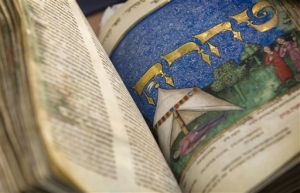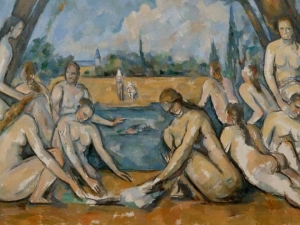|
Displaying items by tag: exhibit
The exhibit — set to close on Wednesday at the center, 1871 N. High St. — will have attracted an estimated 120,000 people, Erik Pepple said, to see 60 masterpieces by Edgar Degas, Jean Dubuffet, Alberto Giacometti, Willem de Kooning, Pablo Picasso and Susan Rothenberg.
The works are from the private collection of Leslie and Abigail Wexner.
An exhibition featuring more than 50 masterpieces by Spanish-born artist Joan Miró opened Sunday, Sept. 14, at the Nasher Museum of Art at Duke University.
The Nasher Museum is the only East Coast venue for “Miró: The Experience of Seeing,” a presentation of the final 20 years of Miró’s career. The exhibition includes 27 sculptures, 18 paintings and six drawings, some of them more than 6 feet tall. All works are on loan from the Museo Nacional Centro de Arte Reina Sofia, Madrid, Spain. The exhibition is on view at the Nasher Museum through Feb. 22, 2015.
Three African sulcata tortoises that were part of a controversial exhibit at the Aspen Art Museum have been relocated to a warmer climate more than a month ahead of schedule, after the veterinarian in charge of their care determined that weather conditions are too cold and wet to ensure their well-being.
The three tortoises have been held in an 800-square-foot pen on the new museum building’s roof deck with iPads mounted on their shells, with footage of local ghost towns playing on the screens.
The 7-foot-tall sculpture of two feet at Chicago’s Oak Street Beach has legs.
That is, it’s expected to move to other locations around the city as long as the Art Institute of Chicago is hosting an exhibit inspired by René Magritte, the Belgian surrealist artist. The beach installation is a larger-than-life marketing campaign to bring attention to the Magritte exhibit at the Art Institute.
The feet, each of which is 800 pounds and made of plywood and carved foam with a urethane hard coat, were installed at Oak Street Beach.

The Baltimore Museum of Art (BMA) filed papers in federal court this week arguing that a painting by Pierre-Auguste Renoir (1841-1919), which was found in a Virginia flea market in 2012, legally belonged to the institution. On the Shore of the Seine (1879) a small landscape painting, had been stolen while it was on view as part of an exhibit at the museum in 1951. A Virginia woman later purchased the work from the flea market for $7, allegedly unaware of the work’s distinguished provenance.
The documents filed on Tuesday, June 4, 2013 in U.S. District Court in Alexandria, VA, claim that no one except the BMA can legally own the Renoir because it belonged to the institution before it was stolen. The buyer of On the Shore of the Seine, Martha Fuqua, has filed her own court papers stating that she deserves to hold on to the painting because she was unaware that the Renoir had been stolen and was subject to FBI forfeiture when she acquired it. Suspicions have surrounded Fuqua’s claim, as her mother is a painter who specializes in reproducing artworks and three friends of Fuqua have come forward saying that they remembered seeing the painting in her home and studio.
After the museum reported On the Shore of the Seine stolen, Fireman’s Fund Insurance Co. paid the institution a $2,500 claim. The company has assured the BMA that it will return the painting to the museum if a judge determines that they are the rightful owners.

In honor of the 150th anniversary of the Norwegian artist’s birth, two museums in Oslo, Norway will organize the most comprehensive exhibit of Edvard Munch’s (1863-1944) work to date. Munch 150, which is currently on view at the National Gallery and the Munch Museum, includes the artist’s most recognizable works including The Scream, Vampire, and The Dance of Life.
The exhibition spans Munch’s extensive career from his earlier works to his death in 1944. The National Gallery’s show focuses on the artist’s formative years from 1882 to 1903 and the Munch Museum is handling his more mature works, created during the last 40 years of life.
Munch is revered for his visceral works that expertly capture the human condition but his home country did not readily accept him as a distinguished artist. In 1940, just days after the Nazis invaded Oslo, Munch bequeathed his entire oeuvre to the city in order to protect it. After the war, his works were placed in a nondescript building in the city, rarely visited, and poorly guarded.
Since then, Munch has become regarded as a highly important artist; exhibitions have been held across the globe to celebrate the 150th anniversary of his birth and a version of The Scream, the only one in private hands, recently sold at auction for a record $119.9 million, securing his role as a powerful presence in the art market. In addition, Oslo authorities agreed to built a new Munch Museum in a more distinguished building, which is expected to open in 2018.
Munch 150, which includes 270 paintings and drawings, will be on view through October 13, 2013.

The Middlebury College Museum of Art in Middlebury, VT is currently exhibiting a selection of rare watercolors and drawings of Vermont by the American painter Edward Hopper (1882-1967). Best known for his depictions of urban and rural life in America, Hopper’s paintings of Vermont are not widely known and many of them have not been on public view in nearly 50 years. Edward Hopper in Vermont, which was assembled from museums and private collections, marks the first time Hopper’s Vermont works have been displayed together in their home state.
Hopper, and his wife Jo, a fellow artist who was also his model, muse, and lifelong travel companion, made five trips to Vermont during the summers between 1927 and 1938. Hopper’s early paintings from these trips depict Vermont’s most recognizable scenery – rolling green hills dotted with bright red barns and dramatic distant peaks. His later paintings focus on the White River Valley and its vast meadows, wide pastures, and everyday roadside scenes. These works are a departure from Hopper’s usual style as they lack any architectural form or signs of human presence.
Edward Hopper in Vermont will be on view at the Middlebury College Museum of Art through August 11, 2013.

On Monday, April 29, 2013 the Metropolitan Museum of Art in New York and the Israel Museum in Jerusalem announced that they had come together to jointly acquire the Mishneh Torah. A rare 15th century illuminated Hebrew manuscript, the Mishneh Torah features text from Moses Maimonides, a Jewish writer and philosopher from the Middle Ages. The Met and the Israel Museum have agreed to exhibit the Torah at both institutions on a rotating schedule.
Created in 1457, the Mishneh Torah is the second of a two-volume manuscript and features six large illustrations and 32 smaller images in the style of Northern Italian Renaissance miniature painting. The Vatican owns the first volume of the manuscript. The Mishneh Torah was restored at the Israel Museum’s conservation lab and has been on loan to the institution since 2007.
The Mishneh Torah was to be the leading item at an auction of the collection of Michael and Judy Steinhardt on Monday at Sotheby’s. The manuscript, which was expected to bring between $4.5 million and $6 million at auction, was purchased by the museums before the sale began. Sotheby’s has declined to reveal how much the two institutions paid for the Mishneh Torah.
Michael Steinhardt, a hedge fund manager and philanthropist, and his wife, Judy, have amassed a renowned Judaica collection, which includes silver and decorative objects, textiles, and fine art. Steinhardt said, “The acquisition of this remarkable manuscript by the Israel Museum and the Metropolitan Museum of Art is poetic given Judy’s and my longstanding involvement with both institutions; it is particularly meaningful that this event marks the first significant collaboration between the two museums.”

The Board of Trustees of the Corcoran Gallery of Art in Washington, D.C. announced an upcoming partnership with the National Gallery of Art. The three-year agreement allows the Corcoran to exhibit works of modern and contemporary art from the National Gallery’s collection while the museum’s East Building is under renovation. The Corcoran is working on trimming expenses and has been battling rumors that it will sell its landmark Beaux Arts building due to financial troubles. During the Board’s announcement, officials scrapped any speculation by confirming that the Corcoran will not be moving.
The Corcoran has collaborated with the National Gallery in the past but their new partnership is the most expansive to date. Earl A. Powell III, Director of the National Gallery of Art, said, “We are very pleased to be able to share works from the nation’s collection of modern art with visitors to the Corcoran while our East Building is closed for renovations. We have a history of lending works to the Corcoran, but the larger number of works addressed by this agreement and the increased length of their exhibition at the Corcoran makes this a new development in our long relationship.”
The National Gallery of Art is expected to close for renovations beginning next year.

Paul Cézanne’s (1839-1906) The Large Bathers is currently on view at the Museum of Fine Arts, Boston. The work, which is on loan from the Philadelphia Museum of Art, is being exhibited alongside the MFA’s own Where do we come from? What are we? Where are we going? by Paul Gauguin (1848-1903).
The Large Bathers, painted in France between 1900 and 1906, is considered one of the most ambitious of Cézanne’s many works exploring the theme of nudes in a landscape. Serene and idyllic, the painting was left unfinished at the time of Cézanne’s death.
Gauguin’s Where do we come from? What are we? Where are we going?, which was painted between 1897 and 1898, also features nudes in a landscape, but as means to illustrate the inevitable passing of time. Upon its completion, Gauguin said, “I believed that this canvas not only surpasses my preceding ones, but that I shall never do anything better – or even like it.” Gauguin attempted suicide after finishing the painting but was unsuccessful.
Exhibited together for the first time in Boston, Large Bathers and Where do we come from? What are we? Where are we going? bridged the gap between art of the 19th and 20th centuries. In doing so, Cézanne and Gauguin influenced a generation of modern artists including Pablo Picasso (1881-1973) and Henri Matisse (1869-1954).
The two paintings will be on view at the MFA through May 12, 2013.
|
|
|
|
|